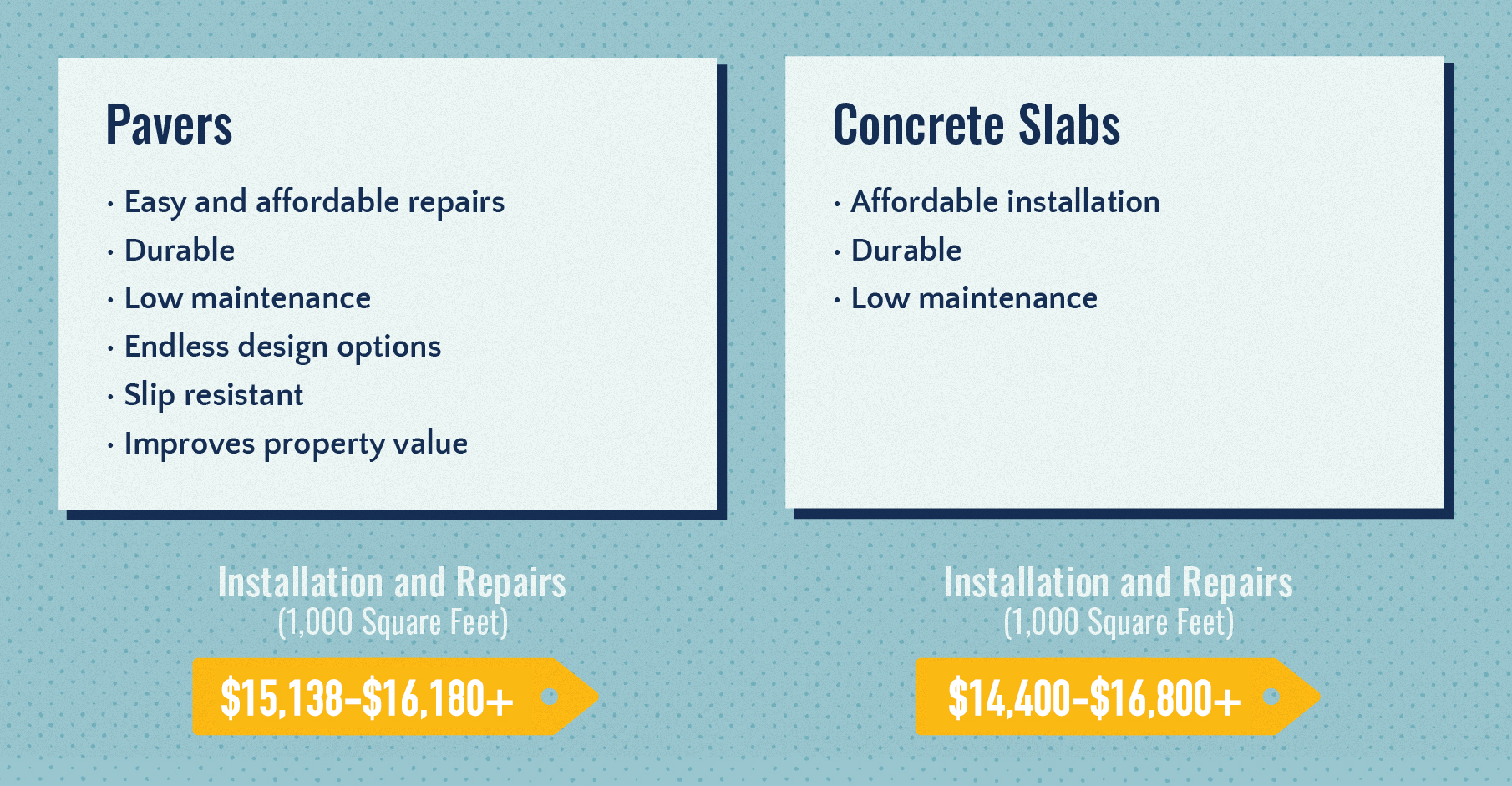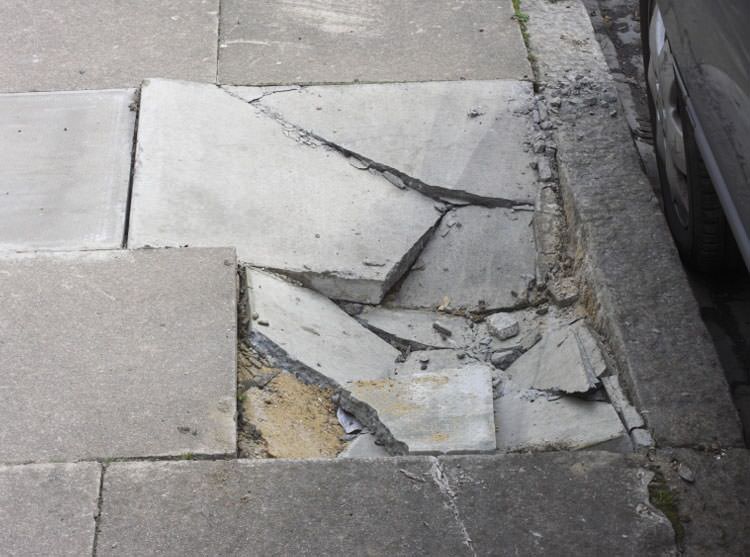Repair Concrete Slab Patio

Dear NH, My concrete driveway and patio have sunken slightly and water puddles whenit rains. Is there a way to level it off? I was thinking of using a cementproduct which will adhere to the existing surface without having to replace thewhole drive and patio?
JDear J,Adding a layer of cement to your driveway and/or patio is one option. Thereare a number of cement products that can be used from plain old concrete mixto special Portland cement mixtures that can be applied as an almost paper-thincoating over existing work.There are a few preparatory steps you should follow to assure the bestadhesion of these products. First, the surface of the old work should be cleanedand roughened slightly. Concrete becomes harder and less porous as it ages.Chemical concrete cleaners containing phosphoric acid will both clean andslightly etch the surface and increase adhesion between the new and old work.The use of muriatic acid, a more powerful acid, is more efficient but much moredangerous to use. There is an article at the website on muriatic acid at.You can decide for yourself if you want to work with this product.If you prefer not to use these chemicals at all, you can mechanically roughenor 'abrade' the surface instead. This would require the rental ofspecial power tools or a sand blasting equipment. Generally speaking, thechemical method is more economical for small jobs such as small sections of apatio or a cement walk.
On the other hand the mechanical method is better forinterior work (no chemical fumes) and large surfaces, such as driveways andpatios. You should still clean the concrete with a detergent of some type. TSPor a TSP-substitute (for those of you living in TSP-free zones) are finechoices.After the surface is cleaned and abraded, it should then be soaked with wateruntil it is completely saturated.
This step prevents the old work from absorbingthe water from the new cement which can cause a 'dry' spot where thetwo meet, producing a weak bond. The concrete should be damp when applying thepatching material, but all standing water should be brushed or wiped off.One step that many of the packaged mixes don't include is what I call'priming' the concrete. After dampening the concrete surface, mix acement 'slurry' a somewhat thinner-than-usual-mix of the patchingcompound and brush it into the concrete surface with a stiff-bristle brushimmediately prior to applying the patching material don't let it dry out!This step helps the old and new work bond by mechanically forcing the cementinto the minute cracks and crevices of the old work. This step is not absolutelynecessary, but it can't hurt!Many hardware stores sell liquid chemical additives that are added to the mixto help new concrete bond to old work.
They also add some extra water and crackresistance to the concrete. These products are wonderful and you shoulddefinitely add some if you use a plain concrete mix for your repair. However, ifyou purchase a cement product designed for patching applications or for thincoatings, don't use any of these additives.If you need to build up the concrete more than an inch but for levelingpurposes to taper the patch into the old work, you may have to do two pours withdifferent cement mixes.

The reason for this is that cement mixes have differentaggregates sand or stones that add strength and act as fillers to reduce thecost of the product. The smaller the aggregate size, the thinner the cement canbe poured. For example, concrete mix (also known as gravel mix) has largeaggregate and cannot be successfully poured thinner than a half inch to an inch.On the other hand, so-called 'topping' or resurfacing mixes with veryfine aggregate can be applied in thicknesses from under an inch to afeathered-edge. So the method for a tapered pour is to first pour the concretemix to at least a half inch below the final desired level. It does not have totroweled smooth.
In fact, a little roughness in the first pour helps the secondpour to grab more effectively! Let the cement set for a few hours and then do asecond pour with the resurfacing or patching mix, feathering it into the oldwork.There is an alternative to resurfacing you might want to investigate. Thereare methods that can be used to raise a sunken slab of virtually any size backto it's original position. A number of companies specialize in 'concreteinjection' a process where a special mixture of cement is injected underpressure underneath the slab, essentially floating the slab back into position.This process is also used to change the slope of a slab that is directing rainwater the wrong way like towards your foundation! These companies have someinteresting names for their repair techniques, too 'slabjacking'and 'mudjacking' are two that come to mind!You might be able to raise the slab yourself if it is not too large andheavy.
You can use a pick or mattock a type of pick with one broad, flat endused for prying or digging to raise the slab high enough to add a fillermaterial beneath it. Various materials can be used. Sand is the easiest to workwith, though small stones or gravel are also acceptable options. You can alsouse concrete provided it doesn't get squeezed out by the pressure of the slab.Place a sheet of plastic under the slab over the wet concrete before loweringthe slab. This will keep the new cement from sticking to the slab just incase you have to relevel it sometime in the future.Some long slabs, such as those used for concrete walks, are made in a singlepour. They usually have expansion grooves cut into them at regular intervals togive the concrete a place to break neatly if stressed instead of crackingrandomly. You can manually chisel out these grooves to separate a long slab intosmaller pieces for lifting.
However, if the slab is reinforced with a steel meshor iron bars, this will not work.Of course, a less laborious fix is to add a leveling layer of cement on topof the old slab. Bringing us back around to the beginning of this question.Amazing how I always end up back at the 'easiest' way to do a job.Again you get to benefit from my lazier side! Need more info?
How To Level A Concrete Patio Slab
Photo: shutterstock.comInstallations of concrete can last hundreds of years, but sooner or later, most end up developing small cracks, gaps, holes, and crevices. If your concrete path, patio, or driveway has begun to show its age, make the necessary repairs sooner rather than later. After all, what’s a small problem today is only going to get bigger and more difficult (or expensive) to fix.
While in some cases it takes a pro to work successfully with concrete, almost anyone can fix cracks in concrete.Here’s how it’s done.MATERIALS AND TOOLS Available on Amazon–––––––. Photo: shutterstock.com STEP 1: Choose your concrete repair product.Concrete surfaces cannot be repaired with concrete.
Instead, use a concrete repair mix; these are readily available at home centers and online. Options include epoxy compounds, latex patching material, and mortar mixes. This last option works best to fill large cracks (or chipped edges), while the other products are suitable for cracks in concrete that are ⅛-inch wide or narrower. STEP 2: Prepare the cracked area for patching.First, use a small hammer and chisel in combination to knock away any cracked, crumbling, or loose concrete. Chip to a depth of about one inch below the surface plane. Then, rinse the area thoroughly, scrubbing with a wire brush to dislodge any loose, lingering particles.Bear in mind that this is dusty work. To facilitate cleanup, you may wish to spread a tarp beneath the work area.
Repair Cracks Concrete Patio Slab
Most important, be sure to wear the proper. STEP 3: Fix the concrete crack with your selected repair product. Epoxy or latex. To concrete cracks ⅛-inch wide or narrower, apply an epoxy or latex patching product , mixed according to the manufacturer’s specifications. The material goes on either with a mason’s trowel or a putty knife. Force it all the way into the crack, then smooth the product level with the surrounding concrete.
Concrete Slab Repair Products
Different mixes cure differently; again, consult the directions listed on your chosen product. Mortar mix.
For larger imperfections in concrete, use a mortar mix. Creating your own mix is as simple as combining one part Portland cement, three parts masonry sand, and just enough water to form a thick paste (though you can also purchase repair mortar mixes, locally or in some cases, online. Moisten (but do not drench) the problem area, then apply the mortar mix with either a mason’s trowel or a. As you work, take pains to eliminate air pockets by pressing down firmly on the applied product. Finally, smooth the patch so that it’s level with the surrounding concrete. Let it cure for about two hours, then cover the area with plastic sheeting to keep it moist. Sprinkle water under the plastic every day for a few days or until the surface has hardened up.Prevent future cracks in concrete by following.